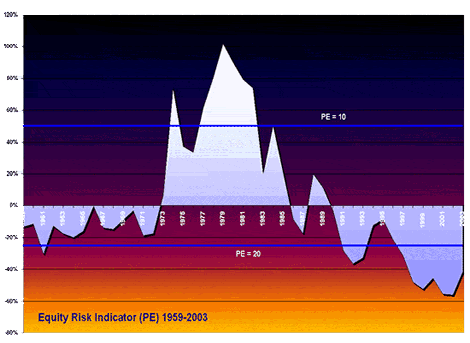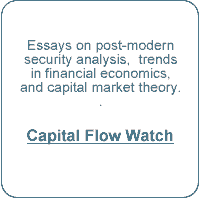 Stock Valuation and the Price Earnings Ratio
Stock Valuation and the Price Earnings Ratio
Earnings-based Valuation of Equities
There is one immutable constant in the stock market: it is and always has been impossible to foresee the future.
We can no more predict the future in the 21st century than our forefathers could in 1910 or 1860.
The price-earnings ratio is a popular measure of equity value.
The mathematical basis for putting a value of equities depends upon the presumed ability to know what will occur, or at least the probabilities of such, not only for a particular company, but for the entire market, as well as inflation and interest rates, fifty to one hundred years forwards.
The price-earnings ratio (PER) is a popular measure of equity value. However, the level of price-earnings that is justified depends upon knowing the future.
If the growth rate of earnings is positive, a higher price-earnings ratio would be justified, but by not knowing the future, we cannot say what future earnings will be and therefore we cannot know what a reasonable price-earnings ratio might be.
Professor Siegel's Contribution
We do know, however, what the average ratio of price to earnings has been over the long history of the U.S. stock market, thanks to a study by Professor Jeremy Siegel of Wharton.
The collective judgment of millions of investors is that stocks are fairly priced at fifteen times earnings.
The collective judgment of tens of millions, representing hundreds of millions of individual investment decisions, in good times and bad, in war and in peace, in inflation and deflation, in hard and soft money, and under the constant constraint of an absolute inability to predict the future, is this: stocks are fairly priced at an average price earnings ratio of about fifteen times earnings.
(See: “Equity Risk Premium Forum, November 8, 2020” , Historical Results I, Jeremy J. Siegel, Wharton School of Business, Philadelphia, Summary by Peter Williamson, Amos Tuck School of Business Administration, Dartmouth College. Published on the Internet in pdf format.)
Sometimes, average price-earnings ratios have risen to twenty (in 1929) or beyond thirty (in the Great Bubble of the 1990s), but always prices have fallen again, sometimes precipitously, sometimes gradually.
There never has been a permanent up or downtrend in price-earnings ratios.
On occasion, average price earnings have dropped to around seven, as during World War I, the Korean War, and the Jimmy Carter stagflation, only to rise again.
At times, an upward trend in price-earnings ratios has gone on for decades, such as during the years 1870-1892 and 1980-2000, and in other periods, price-earnings ratios have eroded slowly for decades, such as during the years 1895-1915.
There has never been a permanent up or downtrend in price-earnings ratios.
The Trouble With Earnings
Unlike cash dividends, corporate earnings are subject to interpretation and opinion; profits are not hard numbers.
Accounting rules are constantly changing as are corporate attitudes regarding disclosure.
Honestly reported earnings may vary by 30% or more, depending upon how accounting standards are interpreted.
At times, companies want to overstate earnings; at other times the opposite is true.
Depending upon the whims of management, the same company with identical operations might present honestly reported and properly audited earnings statements that vary by as much as thirty percent, depending on how accounting standards are interpreted and applied.
Moreover, what future earnings will mean to the investor is also cloudy, since the government can change the tax rate on corporate profits while management readjusts the percentage of earnings to be distributed as dividends.
What we can say with certainty is:
-
we can't predict the future;
-
profits are fuzzy numbers; and
-
for eight generations, investors have been willing to pay, on average, about fifteen times reported earnings for U.S. equities.
With this as a basis, we might say that when stock prices are higher than fifteen times earnings, there usually has been a greater tendency for prices to fall than when price-earnings ratios are below fifteen.
The Fuzzy Logic of Historical PE Ratios
Unlike the Equity Risk (cash) indicator, we can't come up with a commonsense explanation as to why fifteen time earnings should be the magic number.
There are formulas that link price-earnings ratios to earnings growth, the replacement cost of capital and the market value of equity, but to use these formulas we must make assumptions about the future.
Why fifteen times earnings should be the magic number is a mystery.
- Over the period 1919-2003, the average yield on AAA bonds was 5.9%.
- A price-earnings ratio of fifteen is equivalent to an earnings yield of 6.6%.
Comparing cash yield of bonds with the non-cash yield of earnings is like comparing apples with oranges.
However, we can see that a price-earnings ratio of thirty (as during the Great Bubble) with an earnings yield of 3.3% would certainly seem too high relative to long-term bond yields.
It is probable that fancy mathematical justification based on conjecture is not what has caused the central tendency of price-earnings ratios to hover around fifteen for generations, but rather a sense of appropriateness that comes from investors comparing earnings yields with bond yields.
The Equity-Risk Indicator (PE)
The Equity-Risk Indicator (PE) can be calculated by comparing the price-earnings ratio of Standard and Poor's 500 Index with a benchmark of fifteen.
The formula is as follows:

When the average price-earnings ratio is fifteen, the risk indicator (PE) is zero, which signals that the current level of stock prices is in line with the typical long-term level of price-earnings ratios.
A negative indicator would suggest that average stock prices would have to fall to bring the average price-earnings ratio back to fifteen, while a positive indicator means that stock prices would need to rise to reach "normal" levels.
Over a long period, price movement on the U.S. stock market has ranged between ten and twenty times earnings.
The Long-Term Trend
The graph below shows the Equity Risk Indicator (PE) between 1959 and 2003, with two lines for the limits of ten and twenty times earnings.
During the late 1970s (the time of Jimmy Carter's "malaise"), the indicator rose to high positive values.
During the Great Bubble, the indicator dipped to extremely low values.

Because the Equity Risk Indicator (PE) is based on long-term average price-earnings ratios and because the market has shown a cyclical pattern around the mean, this indicator seems to have predictive value.
Over the last half century, there have only been two extended periods during which the indicator was greater than 20% or less than -20%.
These anomalies occurred during pronounced bear or bull markets.
Publishing The Index
We publish this index on this site, under the value tab. The updating of the quarterly equity-risk (PE) index coincides with the Federal Reserve publication of the National Flow of Funds Accounts (Release Z.1).
Before proceeding, check your progress:
Self-Test
Mathematical methods of evaluating stocks depend upon the ability to reasonably:
|
|
Professor Siegel found that the historical average price-earnings ratio of U.S. stocks was :
|
|
Over most of the history of the market, price-earnings ratios of U.S. stocks have typically ranged between:
|
 learning module : continued >
learning module : continued >

| "The Theory of Investment Value", Paperback, John Burr Williams
Published in 1938, this classic defines investment value of common stock as the present value of future dividends. |
| "The Intelligent Investor: The Classic Bestseller on Value Investing", Hardcover, Benjamin Graham
Commonsense that went out of fashion during the Great Bubble |
| "Benjamin Graham: The Memoirs of the Dean of Wall Street", Hardcover, Benjamin Graham, Seymour Chatman, Warren Buffet, Marjorie G. Janis
The father of value investing and teacher of Warren Buffet |
| "The Davis Dynasty: Fifty Years of Successful Investing on Wall Street", Hardcover, John Rothchild
A story of value investing over three generations. |

